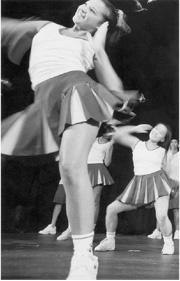A MOVIE ABOUT BIRDS doesn’t sound very exciting, but Mikael Kristersson’s Kestrel’s Eye may well be the most audacious bird movie ever produced. Kristersson, who has been making nature documentaries for over 30 years, eschews voice-over narration for this fea-ture-length work.
The Swedish film opens with a crisp, wintry scene, the camera lingering over several details: A man sweeps snow off a sidewalk; bare trees surround an old church; a kestrel flies over a field, then dives in for its catch. With fresh food in its beak, it returns to the church tower where it makes its nest.
KESTREL’S EYE
directed by Mikael Kristersson
runs February 18-24 at Grand Illusion
Acting as his own cinematographer, Kristersson films these predators at a marvelously close range. We’re right there as they eat a mouse after tearing off its head. We even watch them mate: There’s some squawking for a few seconds, and the male—not one for cuddling—takes off. Later, we’re inches behind the female’s plumage when she lays her eggs. If the birds were ever bothered by the camera, they apparently got used to it.
While the kestrels hunt, eat, and make babies, we’re shown the activities below from their viewpoint. Winter turns to spring, and snow is replaced by new grass and daffodils. Once in a while, joggers turn up. Interestingly, most of the human scenes concern the graveyard next to the tower. We see caretakers—mostly elderly—tending to the plots, sweeping dirt, and watering flowers. It’s a poignant juxtaposition of the vigorous life of the birds and the human preoccupation with death, and it makes one expect the movie will end with the hatching of the kestrels’ eggs.
Yet the film drags on, following the growth of the young fledglings. Their yellow fuzz turns light gray, then dark and clumpy, like lint balls you find in the clothes dryer. In one remarkable scene, the mother is so busy feeding her young that she hardly notices another egg hatching. We watch a pink, bald thing struggling underneath its cracked shell for nearly a minute before the mother sees it. That the director entrusts his audience to remain focused on his virtually silent film is a bold testament of his faith in the visual medium. However, at 86 minutes, Kestrel’s Eye runs too long. Some may find the film poetic and meditative, but also a test of patience after the first hour.







